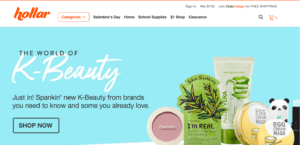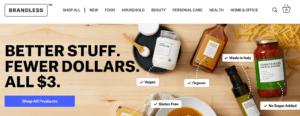How can merchants sell very inexpensive goods and commodities online while staying in business and not charging shipping fees that are nearly as much as the products themselves?
Encourage consumers to buy a lot—regularly.
Doing that requires a combination of offering a very wide range of goods and devising ways to keep them at very low prices, providing special membership shipping programs and finding an uncrowded niche.
That’s what two 2018 Hot 100 retailers—Hollar.com and Brandless.com—are doing.
Online-only dollar store Hollar.com for example, in October launched its Club Orange program, which offers free shipping on every order for $2 a month and is free for the first month. Meanwhile, Brandless Inc.—a consumer packaged goods retailer where everything it sells—from organic extra virgin olive oil to green tea and aloe body wash—is $3—offers a shipping membership that’s just a third the price of Amazon Prime at $36 a year.
Hollar.com, which sells very inexpensive products that usually cost less than $5, was born out of a simple question: Why are few dollar stores online? Hollar, which launched in late 2015, aims to fill that void, says Thanh Khuu, the retailer’s chief technology officer, president and co-founder. Khuu, the former chief technology officer at ShoeDazzle, along with other executives from well-known brands including The Honest Co. and 99 Cent store, worked together to launch the site. “The founding team is [made up of] entrepreneurs in L.A. space ,” Khuu says. “The timing just worked in everyone’s career path.”

Hollar specializes in selling branded goods very cheaply. On a recent day Hollar sold packets of Kool-Aid drink mix for 10 cents each.
Khuu and his colleagues set the bar high for Hollar from the get-go: They gave themselves 100 days to launch. In that time, the slim staff handled inventory sourcing, building the site and mobile app and warehousing, Khuu says. The company, which has raised $47 million from investors, has been on a fast-growing ride ever since.
Khuu attributes growth to three main factors: First is consumers’ rapid adoption of mobile devices. Less affluent consumers who don’t have a computer but use their mobile phones to go online are a big part of Hollar’s customer base. 70% of traffic is to its mobile app, Khuu says. That may explain that while the Khuu says the company is growing, traffic is down, according to web measurement firm SimilarWeb Ltd. Total traffic to Hollar.com fell to 1.141 million in December from 1.897 million in November.
Finding a good deal is now a badge of honor. Post-recession, there’s a more value-conscious shopper.
“Mobile opens up a broader audience than was possible 10 years ago,” Khuu says. Second, Khuu believes value shopping is not as taboo as it once was. “Finding a good deal is now a badge of honor,” he says. “Post-recession, there’s a more value-conscious shopper.” Third is that Hollar is one of the first to market itself as a web-based dollar store, Khuu says. “No one has done this at scale to date,” he says.
Until recently, Hollar sourced and owned all its own items. That included working with vendors in Los Angeles to buy branded goods such as Dove, Mattel and Disney products at a steep discount, direct sourcing from China and launching its own private-label lines of some kitchen, toys and houseware goods. But the e-retailer’s business model is evolving. In July, Hollar launched an online marketplace that allows outside merchants to sell products on Hollar. The goal is to offer as much variety as possible.
“We needed a larger breadth of inventory on the site,” Khuu says. “We want the experience to be around discovery of new products. We will always have a first party component to the business. But third party sellers allow us to offer many more products without having to invest significant additional dollars.” Hollar takes a cut of third party sellers’ sales on the site and that amount varies by seller, Khuu says.

Brandless’ pitch is to call out desirable product attributes and sell at a flat, low price.
At Brandless.com each item, the retailer pledges, is “bad-stuff-less and goodness-ful.” At a time when retailers seek to differentiate themselves from Amazon, Brandless, by its very nature, does just that. To bolster its case, the retailer has coined (and trademarked) a term, “BrandTax,” which it defines as the hidden costs consumers pay for a national brand. It estimates that the average shopper pays at least 40% more for products that are a comparable quality to the ones it sells—and in some categories, such as beauty products like face cream, it contends that markup is up to 370% more. “We’re here to eliminate BrandTax™ once and for all,” the retailer’s website declares.
To ensure consumers understand the message, the retailer has a team that benchmarks prices across five major online and offline retailers. It uses that information to calculate the average BrandTax for each item in its “everyday essentials” selection, which it then presents to customers on their account page. Rather than emblazon its site or its packages with a big, flashy logo, it keeps things simple. The word Brandless, in black, is surrounded by a rounded rectangle.
The retailer emphasizes that quality is key to its offerings; its products do not contain genetically modified organisms, and are sometimes organic, fair trade, kosher, gluten free and/or have no added sugar. In each category, consumers can sort through the retailer’s products based on those attributes. For instance, in the site’s “food aisle” shoppers can narrow their options by certified organic, gluten free, non-GMO, vegan, no added sugar and/or certified kosher. On the front of its packages Brandless highlights those same key attributes. For example, on the front of its vanilla cocoa granola, it notes the product is non-GMO, whole grain, with no artificial colors, flavors or artificial preservatives. On the back it includes more attributes and nutritional information.
Brandless, which just lunched last summer, has already attracted investments. It’s raised $50 million in three funding rounds. However, traffic figures show it has its work cut out to keep shoppers interested. While its monthly unique visitors since its launch in July total 523,030—an ample amount for a new business, its December traffic was down 3.4% to 605,872 from 627,703 in November.
To read about other innovative online retailers, download the free issue of Internet Retailer’s 2018 Hot 100.
Favorite